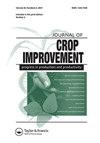利用美国农业部的公开数据进行花生抗蜇线虫的全基因组关联研究和基因组选择
IF 1.5
Q3 AGRONOMY
引用次数: 0
摘要
在美国,栽培花生(Arachis hypogaea L.)的价值每年为12.8亿美元。刺线虫,长尾线虫,是一种能破坏花生生产的外寄生病原体。对这种病原体进行抗性育种是限制其对花生破坏性影响的最经济实惠的方法之一。利用分子工具可以进一步加速刺线虫抗性品种的开发。本研究的目的是利用公开的数据集鉴定花生中与刺线虫抗性相关的单核苷酸多态性(SNP)标记,并评估基因组选择在预测刺线虫抗性方面的准确性。SNP的发现是通过全基因组关联研究(GWAS)在775个美国农业部花生样本中进行的,这些花生被表型为对刺线虫的抗性。GWAS使用13,306个过滤的snp,在TASSEL中使用三种不同的统计模型运行。结果表明:(1)单标记回归、广义线性模型(PCA)、广义线性模型(Q)、混合线性模型(PCA)和混合线性模型(Q)分别发现9个、13个、18个、2个和4个snp与刺线虫抗性相关;(2)模型间有两个snp重叠;(3)使用GWAS的snp拟合模型时,基因组选择更高。据我们所知,这是第一份与花生抗刺线虫抗性相关的SNP标记和基因组选择的报告。这些结果可用于制定花生抗刺线虫分子育种策略。本文章由计算机程序翻译,如有差异,请以英文原文为准。
Genome-wide association study and genomic selection for sting nematode resistance in peanut using the USDA public data
ABSTRACT Cultivated peanut (Arachis hypogaea L.) is valued at $1.28 billion annually in the USA. The sting nematode, Belonolaimus longicaudatus, is an ectoparasitic pathogen that can devastate peanut production. Breeding for resistance to this pathogen is one of the most affordable ways to limit its damaging effects on peanut. The use of molecular tools can further accelerate the development of sting nematode-resistant cultivars. The objectives of this study were to identify single-nucleotide polymorphism (SNP) markers associated with sting nematode resistance in peanuts using publicly available datasets and to assess the accuracy of genomic selection in predicting the resistance to sting nematode. SNP discovery was conducted using a genome-wide association study (GWAS) in a peanut panel consisting of 775 USDA accessions, which were phenotyped for sting nematode resistance. GWAS was conducted using 13,306 filtered SNPs, run in TASSEL with three different statistical models. Results showed that (1) a total of 9, 13, 18, 2, and 4 SNPs, respectively, were found to be associated with sting nematode resistance using the single-marker regression, generalized linear model (PCA), generalized linear model (Q), and mixed linear model (PCA), and mixed linear model (Q), respectively; (2) two SNPs overlapped among the models; and (3) genomic selection was higher when the SNPs from GWAS were used to fit the model. To the best of our knowledge, this is the first report on SNP markers associated with and genomic selection for sting nematode resistance in peanuts. These results can be used to develop a molecular breeding strategy to select for sting nematode resistance in peanuts.
求助全文
通过发布文献求助,成功后即可免费获取论文全文。
去求助
来源期刊

Journal of Crop Improvement
Multiple-
CiteScore
3.30
自引率
7.70%
发文量
42
期刊介绍:
Journal of Crop Science and Biotechnology (JCSB) is a peer-reviewed international journal published four times a year. JCSB publishes novel and advanced original research articles on topics related to the production science of field crops and resource plants, including cropping systems, sustainable agriculture, environmental change, post-harvest management, biodiversity, crop improvement, and recent advances in physiology and molecular biology. Also covered are related subjects in a wide range of sciences such as the ecological and physiological aspects of crop production and genetic, breeding, and biotechnological approaches for crop improvement.
 求助内容:
求助内容: 应助结果提醒方式:
应助结果提醒方式:


